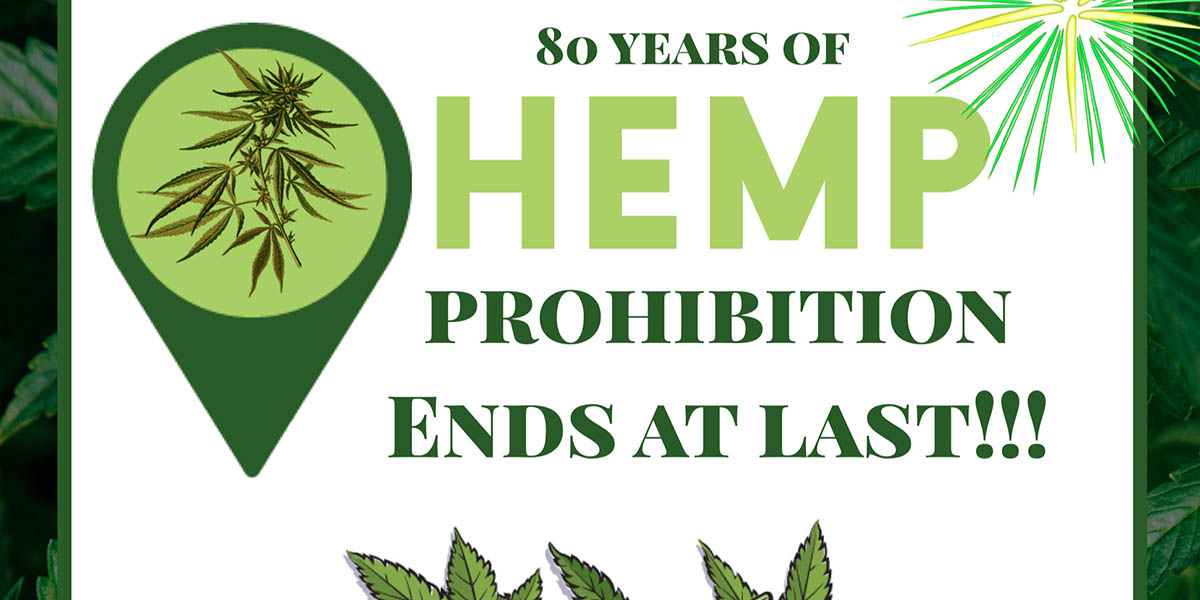After 80 years of federal prohibition, the hemp plant has finally been “re-legalized” by President Trump signing this historic farm bill. This is a momentous shift for the cannabis industry in general and should help to begin rapidly deconstructing the stigma of cannabis in the eyes of the American public. The history of hemp has a sordid past, wrought with insider conflict of corporate barons, all jockeying to retain positions of their dominant industries. Thanks to the hard work Jack Herer, much of this corporate cronysim was disclosed in his book, The Emperor Wears No Clothes. But today we will not dive into the dark side of hemp prohibition, but instead remind you of hemp’s importance in the founding years of the United States of America and also include worthwhile elements noted about the farm bill.
If you’re interested in hemp, please take a moment and read over these stats:
American Historical Notes – From JACKHERER.COM
- In 1619, America’s first marijuana law was enacted at Jamestown Colony, Virginia, “ordering” all farmers to “make tryal of “(grow) Indian hempseed. More mandatory (must-grow) hemp cultivation laws were enacted in Massachusetts in 1631, in Connecticut in 1632 and in the Chesapeake Colonies into the mid-1700s. Even in England, the much-sought-after prize of full British citizenship was bestowed by a decree of the crown on foreigners who would grow cannabis, and fines were often levied against those who refused.
- Cannabis hemp was legal tender (money) in most of the Americas from 1631 until the early 1800s. Why? To encourage American farmers to grow more. You could pay your taxes with cannabis hemp throughout America for over 200 years.2 You could even be jailed in America for not growing cannabis during several periods of shortage, e.g., in Virginia between 1763 and 1767. (Herndon, G.M., Hemp in Colonial Virginia, 1963; The Chesapeake Colonies, 1954; L.A. Times, August 12, 1981; et al.)
- George Washington and Thomas Jefferson grew cannabis on their plantations. Jefferson,3 while envoy to France, went to great expense, and even considerable risk to himself and his secret agents, to procure particularly good hempseeds smuggled illegally into Turkey from China. The Chinese Mandarins (political rulers) so valued their hemp seed that they made its exportation a capital offense.
- The United States Census of 1850 counted 8,327 hemp “plantations”* (minimum 2,000-acre farms) growing cannabis hemp for cloth, canvas and even the cordage used for baling cotton. Most of these plantations were located in the South or in the Border States, primarily because of the cheap slave labor available prior to 1865 for the labor-intensive hemp industry. (U.S. Census, 1850; Allen, James Lane, The Reign of Law, A Tale of the Kentucky Hemp Fields, MacMillan Co., NY, 1900; Roffman, Roger. Ph.D., Marijuana as Medicine, Mendrone Books, WA, 1982.)
Benjamin Franklin started one of America’s first paper mills with cannabis. This allowed America to have a free colonial press without having to beg or justify the need for paper and books from England.
In addition, various marijuana and hashish extracts were the first, second or third most-prescribed medicines in the United States from 1842 until the 1890s. Its medicinal use continued legally through the 1930s for humans and figured even more prominently in American and world veterinary medicines during this time. Cannabis extract medicines were produced by Eli Lilly, Parke-Davis, Tildens, Brothers Smith (Smith Brothers), Squibb and many other American and European companies and apothecaries. During all this time there was not one reported death from cannabis extract medicines, and virtually no abuse or mental disorders reported, except for first-time or novice-users occasionally becoming disoriented or overly introverted. (Mikuriya, Tod, M.D., Marijuana Medical Papers, Medi-Comp Press, CA, 1973; Cohen, Sidney & Stillman, Richard, Therapeutic Potential of Marijuana, Plenum Press, NY, 1976.)
A New America
So as we enter a new era of farming, hemp now stands to be a MAJOR game changer for farmers all across the country. Some worthwhile elements to note about the new farm bill:
This version of the bill places industrial hemp — which is defined as a cannabis plant with under 0.3% of tetrahydrocannabinol, or THC — under the supervision of the Agriculture Department and removes CBD from the purview of the Controlled Substances Act, which covers marijuana. The law also “explicitly” preserved the Food and Drug Administration’s authority to regulate products containing cannabis, or cannabis-derived compounds.(https://www.marketwatch.com/story/cbd-and-hemp-are-now-legal-in-the-us-so-what-does-that-mean-for-pot-companies-2018-12-20)
- While the move has been widely characterized as outright legalization, it’s important to note that strict regulations still apply. Although hemp will no longer be in the jurisdiction of the Department of Justice, prospective growers will have to submit cultivation plans to the US Department of Agriculture (USDA), either through the state government or the USDA itself. The Farm Bill ensures that any cannabinoid — a set of chemical compounds found in the cannabis plant — that is derived from hemp will be legal, if and only if that hemp is produced in a manner consistent with the Farm Bill, associated federal regulations, association state regulations, and by a licensed grower. (https://www.bostonglobe.com/news/marijuana/2018/12/20/hemp-officially-legalized-with-president-trump-signature-farm-bill/aKmNr3iS2AVJuRUbLPnz6I/story.html)


